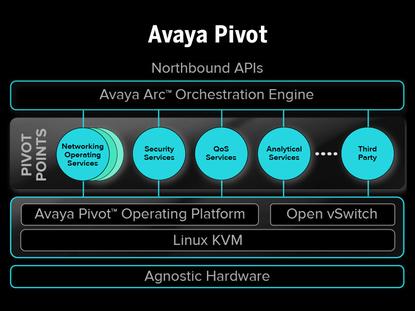Avaya plan deploys network virtualization, segmentation to guard business jewels
- 14 April, 2017 07:24

IDG
Avaya has rolled out products it says will help enterprise customers more easily segment traffic between widely dispersed networked resources and effectively protect corporate data.
The two central components of what the company calls its Data Center Everywhere plan include a new hardware-independent operating system for the company’s switches – the Virtual Service 8000 non-Avaya products such as x86, or ARM platforms – that lets customers deploy virtualized network functions anywhere in the network.
+More on Network World: Cisco, Mitel, NEC and others are targeting Avaya’s customers as the networking company goes through Chapter 11 bankruptcy+
“Avaya Pivot houses virtual network service containers and the services, called Pivot Points, can include a virtualized network operating system, network virtualization, firewall, IDS/IPS, QoS, and gateways. Acting like a hypervisor for virtual machines, Linux, KVM and Open vSwitch are the software elements that operate and manage the virtual network service containers, the company said.
The other product – Avaya Arc – is an orchestration engine that can coordinate the traffic and control amongst Pivot Points. With the Avaya Arc orchestration engine, these functions can be automatically chained together into full-featured services using centralized policy-based tools. Individual functions could include network virtualization, firewall, IDS/IPS, QoS, and specialized gateways, which are selected based upon the unique requirements of a particular application,” Avaya stated.
+More on Network World: Avaya Surge protects the Internet of Things+
“It is ideal for using on data centers that have a lot of east-west traffic where you could deploy a virtual firewall for one set of resources which would be faster and cheaper than deploying a physical firewall in front of network resources,” said Zeus Kerravala, founder and principal analyst of ZK Research. “It would also offer customers a quick way to spin up containers, and keep them segmented and secure – traditional tools take way too long and are expensive.”
The package also enables user to -- as Avaya likes to call it -- hyper-segment their networked assets.
“Avaya hyper-segmentation creates dead ends for hackers. If one segment of the network is attacked, hyper-segmentation prevents uncontrolled access everywhere. Any damage is contained to one isolated segment. And, in the age of IoT, scalability is important: you can set up any number of isolated segments quickly, easily and securely,” Avaya stated.
In addition to Pivot and Arc, Avaya said it added a new switch --the VSP 8600 Modular Switch that supports up to 21.6Tbps switching capacity and incorporates an architecture with control processors on every interface card that, when used in combination with Avaya Pivot, can provide ample load balanced processing power to deliver network function virtualization. The box can support up to 48 ports of 100 Gigabit Ethernet, 128 ports of 40 Gigabit Ethernet or up to 192 ports of Gigabit/10 Gigabit Ethernet.
Taken it’s unclear of the new offering would attract new customers or be more inviting for existing Avaya customers, experts said.
Avaya is trying to stay competitive in the face of massive uncertainty about its future. First, it filed for Chapter 11 protection earlier this year and then in March Extreme said it was buying Avaya’s networking business for $100 million. At the time Norman Rice, an executive vice president with Extreme added that some of Avaya’s strengths included its networking fabric and Network Micro-Segmentation technology that helps customers secure enterprise components were of chief interest to Extreme.
+More on Network World: Extreme grabs Avaya’s networking business for $100M+
There has been some customer concern being expressed on the Reddit Networking subreddit site, which starts of stating: “So...who's ready to start learning CISCO?” Another Reddit poster wrote: “I already retrained from Nortel once and look how that turned out. Not hugely optimistic at the moment. Feels like Avaya are behind others at the moment and with this news, what right minded Telecoms manager will sanction buying new Avaya equipment right now?....”
And things aren’t apparently moving along as Reuters this week reported Avaya said in court papers it needed an extra 120 days for producing a restructuring plan to hold talks with stakeholders on reaching a consensual deal to emerge from bankruptcy. In papers filed in Bankruptcy Court in New York, Avaya asked for a court order that would extend the period in which it has sole right to file a restructuring plan through September 16 and the period for soliciting votes for the plan through November 15.
For its part Avaya corporate treasurer John Sullivan wrote in Network World about how Avaya arrived at Chapter 11 saying among other things “After looking at the multiple options of how to deal with our debt, we decided it was a critical next step in our transformation from a hardware company to a software and services company and the best path forward for our customers, partners and employees. Our business is healthy and performing well. We have successfully transformed from our hardware heritage, with 75% of revenue now generated by software and services. All of our recent products are virtualized and run on various hardware platforms. We continue to be number one or two in the key markets we serve, and are at the beginning of new product cycles across our business.”
